2013 Sea-Doo GTX 215 Review
Former flagship still a force on the water
Once the undisputed flagship of the brand, the Sea-Doo GTX 215 now sits about second or third on the totem pole in the brand’s Luxury Performance hierarchy. Still, it remains one of the brand’s most appealing models. And the reason is that it simply offers a lot. The coolest new features? It’s got them, in abundance. A great hull and strong engine? Add them to the list as well. The only thing you really give up on the GTX 215 is a little bit of power. But as our tests repeatedly show, it’s really not all that much.
And then there’s that one thing always worth considering – price. By foregoing a little of the newest flagship’s horsepower and suspension, you can save substantially.
COMPARISON: Read our review of the 2013 Sea-Doo GTR 215
iEverything
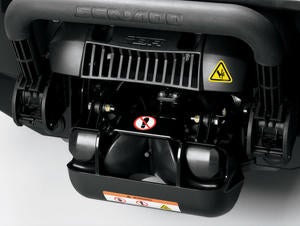 The key component of Sea-Doo’s iControl features is the Intelligent Brake and Reverse.
The key component of Sea-Doo’s iControl features is the Intelligent Brake and Reverse.There are plenty of features that make a GTX stand out, but it’s nearly impossible to overlook the all-encompassing “i” monikers, namely Intelligent Brake and Reverse (iBR) and Intelligent Throttle Control (iTC), all part of what Sea-Doo dubs iControl.
As the name implies, iControl features allow the operator to have just that – control. In terms of Intelligent Brake and Reverse, it means the craft offers a literal brake, a modified reverse bucket that drops into place when called upon and redirects water flow forward to provide stopping power. iControl ensures you won’t get launched over the handlebars. Instead, it interrupts thrust at the pump for just a microsecond as the bucket drops into place. It then reapplies that thrust so that it bounces off the bucket walls and is forced forward and to the sides, rapidly slowing the craft and decreasing overall stopping distance by about 100 feet. The force of the stop corresponds to how hard the driver squeezes the brake/reverse lever on the left handgrip. iControl prevents so much force from being applied that the driver gets launched; the force is also from the back and low to prevent the craft from nosediving. Over the years, I’ve even learned to feather the lever in high-speed stops, just like you would in a car.
COMPETITION: Read our review of the 2012 Yamaha FX Cruiser HO
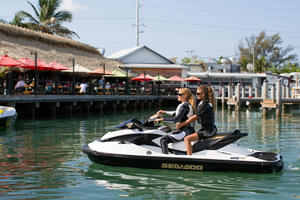 Sea-Doo’s braking is perhaps most useful for low speed handling.
Sea-Doo’s braking is perhaps most useful for low speed handling.Obviously braking has its advantages, but I’m becoming a broken record in saying that what I think it does best is improve low-speed handling in tight quarters. Why? With iBR, Sea-Doos start in neutral. That bucket tips just right to pretty much arrest any forward or backward motion. Squeeze the throttle and you move forward, squeeze the brake/reverse lever and you stop, or move backward. iBR provides a level of confidence that is a boon to newcomers, but also readily appreciated by seasoned veterans who have seen many riders bump docks…or worse. A rider’s eyes also stay focused on the water, rather than looking down for a console-mounted lever.
Intelligent Throttle Control also makes use of the boat’s brains to exploit the advantages of electronic throttle. Cruise Control and a No-Wake Mode are obvious benefits. With cruise, just find a speed you like, press a button, and the boat will maintain it while you simply squeeze the throttle fully, taking pressure off a trigger finger.
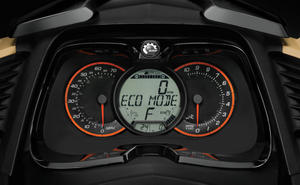 Three different acceleration curves are available. ECO mode (pictured) offers the greatest fuel efficiency.
Three different acceleration curves are available. ECO mode (pictured) offers the greatest fuel efficiency.Release the lever and the system disengages. Small adjustments can be made via up/down keys. No-wake locks the speed in at about 5 mph for those long no-wake zones and keeps it there, requiring absolutely no pressure on the throttle. Worried you’ll fall off and the boat will continue on its merry way? The safety lanyard stops the engine.
Sea-Doo doesn’t stop at just cruise and no-wake. Engineers also take advantage of electronic throttle to offer up different acceleration curves. Typically, the GTX will start in Touring mode, which slightly tames the craft’s acceleration for a little gentler ride. Switch to Sport and that acceleration curve gets steeper, with the full (stock) potential of the engine on hand. A third mode, ECO, can be chosen to operate with the greatest fuel efficiency.
COMPETITION: Read our review of the 2013 Kawasaki Jet Ski Ultra LX
Speed? Handling? Check.
All those “i” things undoubtedly improve the ride experience, but even without them the GTX is a pretty solid ride. The GTX is Sea-Doo’s flagship hull. It’s comfortable, handles aggressively in calm water and tames the rough stuff. It’s also very predictable. Newcomers will relish the stability and confidence it inspires, performance riders will love to push it hard into a corner and feel like a racer. Like straight-out speed? The GTX’s stepped hull design is a trait borrowed from speedboats, aimed at reducing drag and producing a faster top speed number.
Naturally, the engine has a lot to do with what that number is. As the name suggests, this is the approximately 215 hp variant of Sea-Doo’s 1,494cc 4-TEC, boosted by a supercharger and intercooler. Pin the throttle and you’ll experience strong acceleration in Sport mode (more than enough for towing skiers and wakeboarders) and a top speed for both Sport and Touring mode just shy of the flagship 260 (about 64-65 mph in good conditions and with a light load).
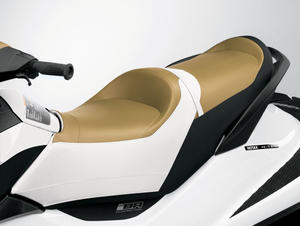 Riders and passengers alike will appreciate Sea-Doo’s sculpted, stepped touring seat.
Riders and passengers alike will appreciate Sea-Doo’s sculpted, stepped touring seat.So what else do you get beside iControl and pretty impressive performance and handling? Start with the driver’s perch, a sculpted, stepped touring seat designed to offer the driver good back support and elevate passengers above so that they’re not simply checking out the captain’s haircut most of the ride. Unlike competitors, that seat is hinged and stays open on a pneumatic strut. That eliminates finding a spot to set the seat down every time you want to check out the engine compartment, which in turn should limit damage. In that seat the driver enjoys adjustable wide-angle mirrors to keep tabs on what’s happening behind. Should anyone get ejected, or just intentionally choose to take a dip, a fold-down boarding step eases the transition back aboard.
Sea-Doo standbys include electronic trim, tilt steering, a full information display, and the Learning Key lanyard system, which uses a secondary lanyard to dramatically govern power. The digitally encoded lanyard also prevents unauthorized use.
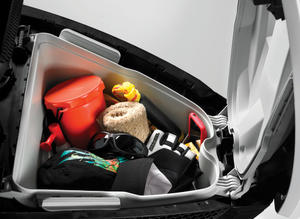 The only major fooble on the GTX 215 is its limited storage space.
The only major fooble on the GTX 215 is its limited storage space.The only real miss continues to be storage. The stylish GTX makeover several years back provided a lot of benefits, but limited storage to under 14 gallons. That’s far less than competitive models. Owners may also love or hate the removable storage bin. On the positive side it’s water tight and removable; on the negative it adds another layer of complexity when you’re simply trying to grab something quickly out on the water.
The Final Word
If you’re keeping score, that’s a lot of pluses overall. Features, performance, handling, all combine to make the GTX 215 an attractive buy. It may no longer hold the top spot on the totem pole, but hey, have you ever really looked at one? If you have, you know there’s a lot of interesting things carved at each step of the way.
It would be a shame to overlook them.
| Sea-Doo GTX 215 Specs | |
| Length | 139.2 inches |
| Beam | 48.2 inches |
| Dry Weight | 824 lbs |
| Engine | Supercharged with intercooler, three-cylinder |
| Displacement | 1,494 cc |
| Bore and Stroke | 100 mm x 63.4 mm |
| Compression Ratio | 8.4:1 |
| Rated Horsepower | NA |
| Fuel Capacity | 15.9 gal. |
| Combined Stowage Capacity | 13.7 gal. |
| Colors | Pure White with Gold |
| Price | $13,299 |
Get PersonalWatercraft.com in your Inbox!
Like PersonalWatercraft.com on Facebook
Comments
Most Popular

2025 Yamaha JetBlaster PRO 2-Up Review

2024 Kawasaki Jet Ski STX 160X Review

Remembering the Sea-Doo XP

Whatever Happened to the Wetbike?

2025 Yamaha JetBlaster Review




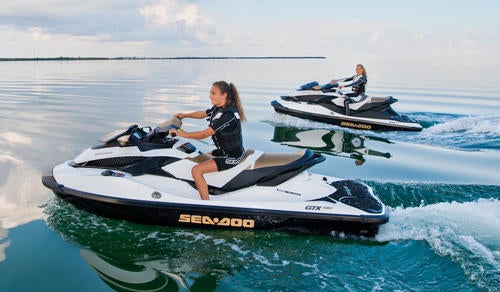
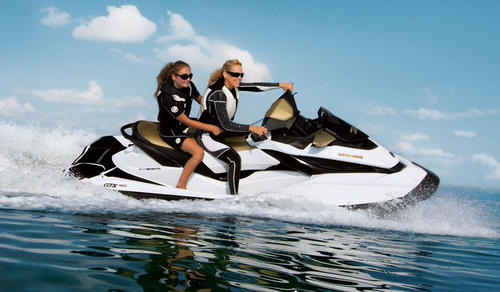







 Your Privacy Choices
Your Privacy Choices